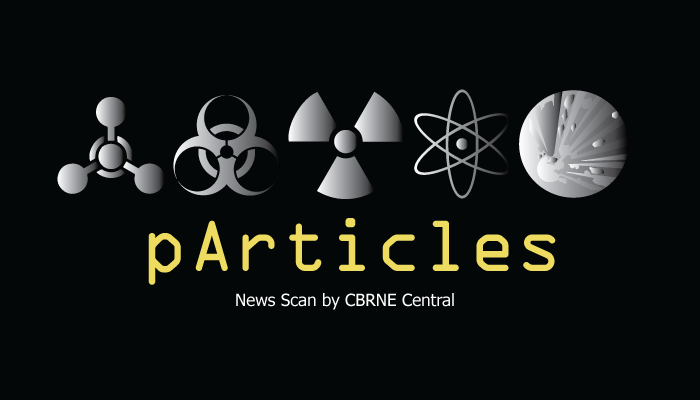Topics in this issue include radiation sniffer planes, 9/11 first responder illnesses, EPA water rules for nuclear emergencies, and bombing an ISIL chemical weapons factory.
In This Article
US to Fly ‘Radiation Sniffer’ Jet Off Korean Peninsula
The US Air Force is expected to fly its “radiation sniffer” jet off the Korean Peninsula to take air samples to determine if a nuclear event occurred in North Korea. The Air Force WC-135 jet, dubbed the “Constant Phoenix,” will look for distinctive elements a nuclear test of any type would emit into the air. The collected samples can be analyzed to determine exactly what occurred. CNN >>
‘Babushkas of Chernobyl’: Stubborn Sisterhood Thriving in Radioactive Zone
The story of brave Babushkas whom have survived an incredible journey, from Stalin’s famines in 1930’s to Nazi invasion and on end the horrifying nuclear disaster in Chernobyl. Slavorum >>
9/11 First Responders Recount Illnesses from Ground Zero Work
Daniel Rodriguez was a police officer on Sept. 11, 2001, who found himself assigned to a temporary morgue near the downed towers, where he said “you can’t help but see things.” He became much better known in the days and years afterward when his rich tenor earned him fame as the “The Singing Policeman” and the “voice that healed a nation” in a succession of renditions of the national anthem and “God Bless America” at a 9/11 tribute at Yankee Stadium, on talk shows, at numerous events and funerals. Emergency Management >>
Health Care Providers Scramble to Meet New Disaster Readiness Rule
An estimated 72,315 American health care providers and suppliers — from hospitals and nursing homes to dialysis facilities and care homes for those with intellectual disabilities — will have a little over a year to meet federal disaster preparedness requirements completed this week by the Centers for Medicare and Medicaid Services. NY Times >>
When an Airport Scanner Sees a Cyst as a Security Threat
A traveler with a bulge in their body from a cyst or hernia might get flagged for an invasive airport security screening to look for explosives, a case report suggests. In many larger airports, X-rays have been replaced in recent years by machines that use radio frequencies to detect suspicious items on travelers, researchers note in JAMA Dermatology. Reuters >>
EPA Proposes New Water Rules for Nuclear Emergencies
In the wake of a nuclear emergency, the Environmental Protection Agency thinks it would be acceptable for the public to temporarily drink water containing radioactive contamination at up to thousands of times normal federal safety limits. Wall Street Journal >>
Reactor Shutdown Threatens World’s Medical-Isotope Supply
Next month, Canada’s Chalk River nuclear-research reactor will halt production of a medical isotope that is widely used in diagnostic scans. Any unplanned outages at the world’s remaining production sites could lead to severe shortages of the radioactive tracer technetium-99m until new facilities come online in 2017 and 2018. Nature >>
What I Got Wrong About Assad’s Military Prospects
Early this summer, in a piece titled “Is Assad Delusional?”, I argued that whereas the regime was unlikely to reassert control over all of Syria, its alliance with Iran and Russia would eventually end the strategic threat posed by the insurgency without a pro-rebel international intervention. Recent military developments indicate the analysis was probably wrong. It overestimated the regime’s ability to translate critical Iranian and Russian support to lasting gains on the ground. War on the Rocks >>
How Ionizing Radiation Damages DNA and Causes Cancer
For the first time, researchers have been able to identify in human cancers two characteristic patterns of DNA damage caused by ionizing radiation. These fingerprint patterns may now enable doctors to identify which tumors have been caused by radiation, and investigate if they should be treated differently. Science Daily >>
What Communities Need to Know About Interim Nuclear Waste Storage
The US Department of Energy is planning to use a consent-based approach to select sites for the storage and disposal of spent nuclear fuel and high-level radioactive waste. The strategy for these sites includes a pilot interim storage facility, consolidated interim storage facilities, and two permanent geologic disposal facilities—one for commercial spent nuclear fuel and the other for defense spent nuclear fuel and high-level waste. Bulletin of the Atomic Scientists >>
Decoding North Korea’s Claim of a Successful Nuclear Test
The Korean Central News Agency, the official news service of North Korea, on Friday published a statement issued by the nation’s nuclear weapons institute. In the statement, the use of the phrase “nuclear warhead” rather than “nuclear device” is noteworthy, suggesting a specific, miniaturized design that can be mounted on a missile. D.P.R.K. refers to the Democratic People’s Republic of Korea, the North’s official name, and the Workers’ Party of Korea is the ruling party, led by Kim Jong-un. NY Times >>
Secret Flintshire Chemical Weapons Factory from Second World War Revealed
Historic tunnels that housed thousands of mustard gas shells during the war years have been opened to the public. The Rhydymwyn Valley Works, near Mold, reportedly made 40,000 mustard gas shells a week during the Second World War, as well as carrying out research that helped develop the first atomic bomb. Daily Post >>
The Textbook Definition of Unstable: Why North Korea’s Newest Nuclear Test is Scary
North Korea has tested its fifth nuclear weapon — one more powerful than any device it has tested previously. What does this mean for the world? To find out, I got in touch with Jeffrey Lewis, director of the East Asia Nonproliferation Program at the Middlebury Institute of International Studies at Monterey. Lewis is an honest-to-goodness expert on North Korea’s nuclear program, so what he has to say carries real weight. And what he had to say was scary. Vox >>
North Korea Must Be Forced to Abandon Chemical Weapons
The international community should work together to oblige North Korea to join the Chemical Weapon Convention (CWC) that calls for destroying all existing chemical weapons and never producing them again, said the head of an international chemical weapons watchdog. Korea Times >>
Russia’s 57-Megaton Tsar Bomb: The Biggest Nuclear Weapon Ever Dropped
On July 10, 1961 Soviet Premier Nikita Khrushchev summoned the USSR’s top nuclear weaponeers and told them to promptly resume nuclear testing. After roughing up America’s young new President Kennedy at a Vienna summit in June, Khrushchev was in a mood, according to Andrei Sakharov, to “show the imperialists what we can do.” National Interest >>
The Saddam Factor in North Korea’s Nuclear Strategy
The lynching of the Libyan leader after he had renounced nuclear weapons and the hanging of the Iraqi president have been cited by the North Korean media as the rationale for their own country’s determination not to be put off by sanctions despite the poverty there. After Pyongyang’s last nuclear test in January, a commentary in North Korea’s media said: “History proves that powerful nuclear deterrence serves as the strongest treasured sword for frustrating outsiders’ aggression.” BBC News >>
Surveying Safeguarded Material 24/7
While inspections are at the heart of the IAEA’s verification activities, they are increasingly supplemented by surveillance technologies that operate around the clock. Over a million pieces of encrypted safeguards data are collected by over 1400 surveillance cameras, and 400 radiation and other sensors around the world. More than 23 000 seals installed at nuclear facilities ensure containment of material and equipment. IAEA >>
Massive US Airstrike Hits Suspected ISIS Chemical Weapons Factory
Twelve U.S. warplanes, including a B-52 Stratofortress bomber and A-10 Thunderbolts, carried out a massive airstrike Monday on a suspected chemical weapons production complex in the ISIS-held stronghold of Mosul, Iraq, the commander of U.S. Central Command air forces said Tuesday. The sprawling complex in the Mosul area had been a pharmaceutical factory and was suspected of having been taken over by ISIS to produce “chlorine or mustard gas — we don’t know for sure at this point,” said Air Force Lt. Gen. Jeffrey Harrigian. Military.com >>



